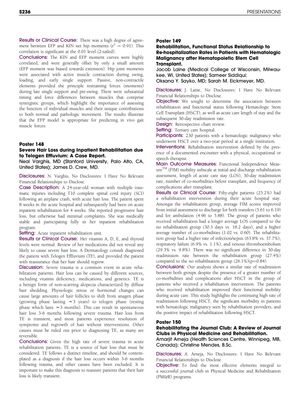Rehabilitation and Functional Status Relationship to Re-Hospitalization Rates in Patients with Hematologic Malignancy after Hematopoietic Stem Cell Transplant
September 2014
in “
PM&R
”

TLDR Rehabilitation improved patients' mobility but did not reduce 30-day hospital readmission rates after stem cell transplants.
In a retrospective chart review of 230 patients with hematologic malignancy who underwent Hematopoietic Stem Cell Transplant (HSCT) at a tertiary care hospital, the study aimed to determine the relationship between rehabilitation, functional status, length of acute care stay, and 30-day readmission rates. Rehabilitation intervention was defined by documented encounters with physical, occupational, or speech therapists. Results showed that 58 patients (25.2%) received rehabilitation during their acute hospital stay, with average Functional Independence Measure (FIM) scores for transfers and ambulation improving from initial assessment to discharge. Patients who received rehabilitation had a longer average length of stay (30.3 days vs. 18.2 days) and more co-morbidities (1.02 vs. 0.60) compared to those who did not receive rehabilitation. Despite a higher rate of complications such as infection/sepsis, respiratory failure, and venous thromboembolism in the rehabilitation group, there was no significant difference in the 30-day readmission rate between the two groups (27.4% for rehabilitation vs. 26.1% for no rehabilitation, p=0.84). The study concluded that rehabilitation improved functional mobility during acute care and highlighted the high rate of readmission and significant morbidity in patients with hematologic malignancy, emphasizing the positive impact of rehabilitation following HSCT.